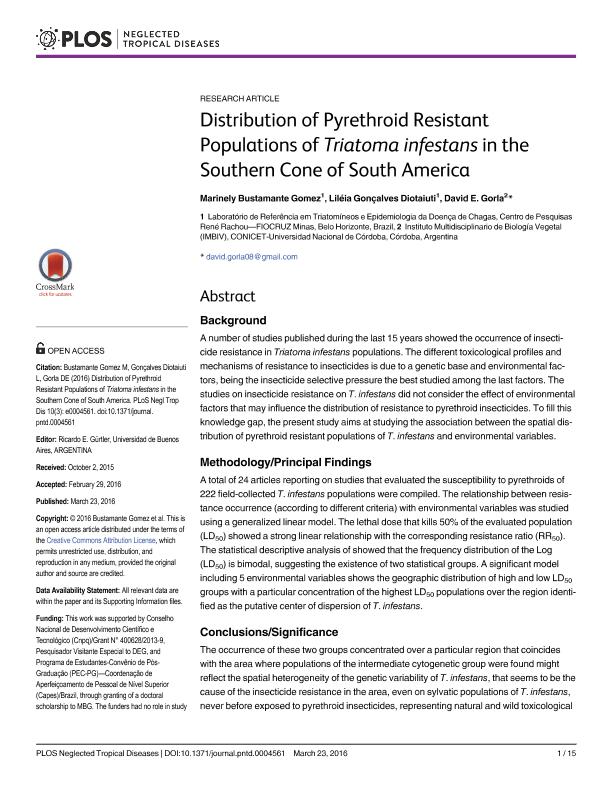Mostrar el registro sencillo del ítem
dc.contributor.author
Bustamante Gomez, Marinely
dc.contributor.author
Gonçalves Diotaiuti, Liléia
dc.contributor.author
Gorla, David Eladio

dc.date.available
2017-06-06T21:54:35Z
dc.date.issued
2016-03
dc.identifier.citation
Bustamante Gomez, Marinely; Gonçalves Diotaiuti, Liléia; Gorla, David Eladio; Distribution of Pyrethroid Resistant Populations of Triatoma infestans in the Southern Cone of South America; Public Library Of Science; Neglected Tropical Diseases; 10; 3; 3-2016; 1-15
dc.identifier.issn
1935-2735
dc.identifier.issn
1935-2727
dc.identifier.uri
http://hdl.handle.net/11336/17654
dc.description.abstract
A number of studies published during the last 15 years showed the occurrence of insecticide resistance in Triatoma infestans populations. The different toxicological profiles and mechanisms of resistance to insecticides is due to a genetic base and environmental factors, being the insecticide selective pressure the best studied among the last factors. The studies on insecticide resistance on T. infestans did not consider the effect of environmental factors that may influence the distribution of resistance to pyrethroid insecticides. To fill this knowledge gap, the present study aims at studying the association between the spatial distribution of pyrethroid resistant populations of T. infestans and environmental variables. A total of 24 articles reporting on studies that evaluated the susceptibility to pyrethroids of 222 field-collected T. infestans populations were compiled. The relationship between resistance occurrence (according to different criteria) with environmental variables was studied using a generalized linear model. The lethal dose that kills 50% of the evaluated population (LD 50 ) showed a strong linear relationship with the corresponding resistance ratio (RR 50 ). The statistical descriptive analysis of showed that the frequency distribution of the Log(LD 50 ) is bimodal, suggesting the existence of two statistical groups. A significant model including 5 environmental variables shows the geographic distribution of high and low LD 50 groups with a particular concentration of the highest LD 50 populations over the region identified as the putative center of dispersion of T. infestans.The occurrence of these two groups concentrated over a particular region that coincides with the area where populations of the intermediate cytogenetic group were found might reflect the spatial heterogeneity of the genetic variability of T. infestans, that seems to be the cause of the insecticide resistance in the area, even on sylvatic populations of T. infestans, never before exposed to pyrethroid insecticides, representing natural and wild toxicological phenotypes. The strong linear relationship found between LD 50 and RR 50 suggest RR 50 might not be the best indicator of insecticide resistance in triatomines.
dc.format
application/pdf
dc.language.iso
eng
dc.publisher
Public Library Of Science

dc.rights
info:eu-repo/semantics/openAccess
dc.rights.uri
https://creativecommons.org/licenses/by/2.5/ar/
dc.subject
Triatoma Infestans
dc.subject
Pyrethroid Resistance
dc.subject
Geographic Distribution
dc.subject
Ecological Niche Modelling
dc.subject.classification
Zoología, Ornitología, Entomología, Etología

dc.subject.classification
Ciencias Biológicas

dc.subject.classification
CIENCIAS NATURALES Y EXACTAS

dc.title
Distribution of Pyrethroid Resistant Populations of Triatoma infestans in the Southern Cone of South America
dc.type
info:eu-repo/semantics/article
dc.type
info:ar-repo/semantics/artículo
dc.type
info:eu-repo/semantics/publishedVersion
dc.date.updated
2017-06-06T14:42:50Z
dc.journal.volume
10
dc.journal.number
3
dc.journal.pagination
1-15
dc.journal.pais
Estados Unidos

dc.journal.ciudad
San Francisco
dc.description.fil
Fil: Bustamante Gomez, Marinely. Centro de Pesquisas René Rachou. Laboratório de Referência em Triatomínueos e Epidemiologia da Doença de Chagas; Brasil
dc.description.fil
Fil: Gonçalves Diotaiuti, Liléia. Centro de Pesquisas René Rachou. Laboratório de Referência em Triatomínueos e Epidemiologia da Doença de Chagas; Brasil
dc.description.fil
Fil: Gorla, David Eladio. Consejo Nacional de Investigaciones Científicas y Técnicas. Centro Científico Tecnológico Conicet - Córdoba. Instituto Multidisciplinario de Biología Vegetal. Universidad Nacional de Córdoba. Facultad de Ciencias Exactas Físicas y Naturales. Instituto Multidisciplinario de Biología Vegetal; Argentina
dc.journal.title
Neglected Tropical Diseases

dc.relation.alternativeid
info:eu-repo/semantics/altIdentifier/url/https://www.ncbi.nlm.nih.gov/pmc/articles/PMC4805280/
dc.relation.alternativeid
info:eu-repo/semantics/altIdentifier/doi/https://dx.doi.org/10.1371%2Fjournal.pntd.0004561
dc.relation.alternativeid
info:eu-repo/semantics/altIdentifier/url/http://journals.plos.org/plosntds/article?id=10.1371/journal.pntd.0004561
Archivos asociados
